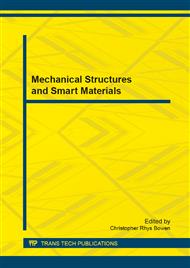p.173
p.177
p.181
p.185
p.189
p.195
p.199
p.204
p.210
Mesoscopic Model for SiCP/Al Composites and Simulation on the Cutting Process
Abstract:
For deep application of the FEM on the study of cutting mechanism of SiCP/Al, the article completed the algorithm to generate the mesoscopic model of SiCP/Al with the parameterization of the shape and volume fraction of SiC based on the ABAQUS scripting language python. Two-dimensional randomly distributed circular particles model, circular mixed with regular polygon particles model and arbitrary polygon model are generated with volume fraction of 30% and cutting simulations were carried out on the models. Results show that cutting force of SiCP/Al with uniform distribution and size of circular particles will be relatively stable and during the cutting process, stress field changes with the shape and distribution of the particles and the relative position of the particles and tool. Poor surface quality was mainly caused by the interaction among the tool, the particles and the matrix material.
Info:
Periodical:
Pages:
189-194
Citation:
Online since:
January 2014
Authors:
Price:
Сopyright:
© 2014 Trans Tech Publications Ltd. All Rights Reserved
Share:
Citation:


